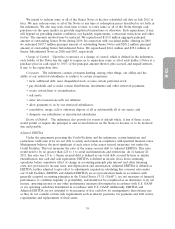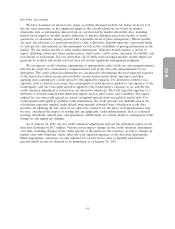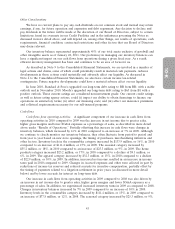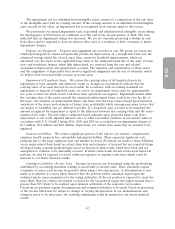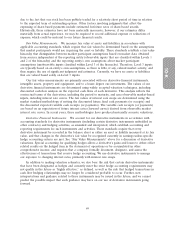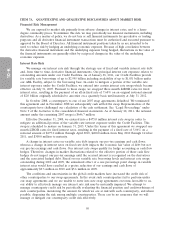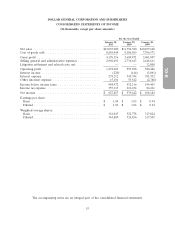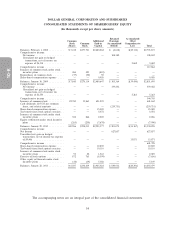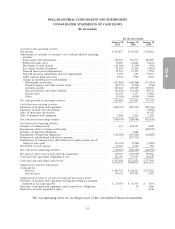Dollar General 2010 Annual Report Download - page 125
Download and view the complete annual report
Please find page 125 of the 2010 Dollar General annual report below. You can navigate through the pages in the report by either clicking on the pages listed below, or by using the keyword search tool below to find specific information within the annual report.
10-K
The impairment test for indefinite-lived intangible assets consists of a comparison of the fair value
of the intangible asset with its carrying amount. If the carrying amount of an indefinite-lived intangible
asset exceeds its fair value, an impairment loss is recognized in an amount equal to that excess.
We performed our annual impairment tests of goodwill and indefinite-lived intangible assets during
the third quarter of 2010 based on conditions as of the end of the second quarter of 2010. The tests
indicated that no impairment charge was necessary. We are not currently projecting a decline in cash
flows that could be expected to have an adverse effect such as a violation of debt covenants or future
impairment charges.
Property and Equipment. Property and equipment are recorded at cost. We group our assets into
relatively homogeneous classes and generally provide for depreciation on a straight-line basis over the
estimated average useful life of each asset class, except for leasehold improvements, which are
amortized over the lesser of the applicable lease term or the estimated useful life of the asset. Certain
store and warehouse fixtures, when fully depreciated, are removed from the cost and related
accumulated depreciation and amortization accounts. The valuation and classification of these assets
and the assignment of depreciable lives involves significant judgments and the use of estimates, which
we believe have been materially accurate in recent years.
Impairment of Long-lived Assets. We review the carrying value of all long-lived assets for
impairment at least annually, and whenever events or changes in circumstances indicate that the
carrying value of an asset may not be recoverable. In accordance with accounting standards for
impairment or disposal of long-lived assets, we review for impairment stores open for approximately
two years or more for which recent cash flows from operations are negative. Impairment results when
the carrying value of the assets exceeds the estimated undiscounted future cash flows over the life of
the lease. Our estimate of undiscounted future cash flows over the lease term is based upon historical
operations of the stores and estimates of future store profitability which encompasses many factors that
are subject to variability and are difficult to predict. If a long-lived asset is found to be impaired, the
amount recognized for impairment is equal to the difference between the carrying value and the asset’s
estimated fair value. The fair value is estimated based primarily upon projected future cash flows
(discounted at our credit adjusted risk-free rate) or other reasonable estimates of fair market value in
accordance with U.S. GAAP. During 2010, 2009 and 2008 we recorded pre-tax impairment charges of
$1.7 million, $5.0 million and $4.0 million, respectively, for certain store assets that we deemed to be
impaired.
Insurance Liabilities. We retain a significant portion of the risk for our workers’ compensation,
employee health, property loss, automobile and general liability. These represent significant costs
primarily due to the large employee base and number of stores. Provisions are made to these liabilities
on an undiscounted basis based on actual claim data and estimates of incurred but not reported claims
developed using actuarial methodologies based on historical claim trends, which have been and are
anticipated to continue to be materially accurate. If future claim trends deviate from recent historical
patterns, we may be required to record additional expenses or expense reductions, which could be
material to our future financial results.
Contingent Liabilities—Income Taxes. Income tax reserves are determined using the methodology
established by accounting standards relating to uncertainty in income taxes. These standards require
companies to assess each income tax position taken using a two step process. A determination is first
made as to whether it is more likely than not that the position will be sustained, based upon the
technical merits, upon examination by the taxing authorities. If the tax position is expected to meet the
more likely than not criteria, the benefit recorded for the tax position equals the largest amount that is
greater than 50% likely to be realized upon ultimate settlement of the respective tax position.
Uncertain tax positions require determinations and estimated liabilities to be made based on provisions
of the tax law which may be subject to change or varying interpretation. If our determinations and
estimates prove to be inaccurate, the resulting adjustments could be material to our future financial
results.
47




